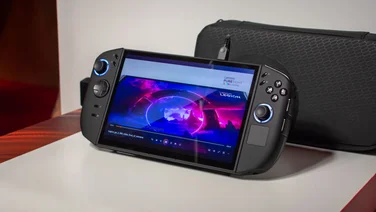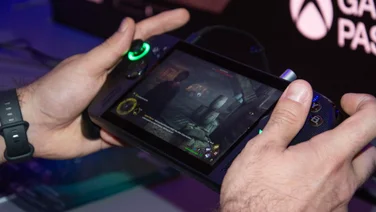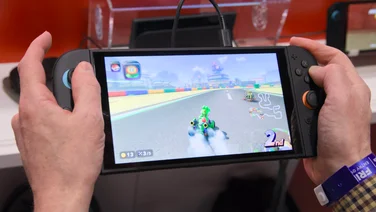To help us provide you with free impartial advice, we may earn a commission if you buy through links on our site. Learn more

- Effective design with rock-solid grip
- Sensitive thumbsticks
- Great analogue triggers
- Doesn’t work in all Android games
- Limited customisation options
Up to a point, gaming on your smartphone has never been so good. On the hardware side, even mid-range phones have better screens and more processing power than you’ll find on any dedicated handheld gaming system bar the Steam Deck. On the software side, you’ve got games as ambitious as Diablo Immortal, Apex Legends: Mobile and Genshin Impact to make use of that hardware, not to mention access to streaming services through Stadia, GeForce Now and Xbox Games Pass Ultimate.
The only thing you don’t have is access to a decent set of physical controls. Touchscreen controls are nearly always horrible: imprecise, prone to error and lacking any tactile feedback. Hooking up a console controller via Bluetooth works but even with a holder for your smartphone, it feels like a cludge.
That’s why attachable controllers like the Razer Kishi, GameSir X2 and Backbone One are beginning to take off. These are designed to clamp onto your phone along the top and bottom edges, sandwiching it between the two halves of a console-style controller, effectively transforming your device into something close to a Nintendo Switch. The original Razer Kishi was one of the first successful attempts to pull this concept off but it still left some room for improvement. That’s very much the starting point of the Kishi v2.
Razer Kishi v2 review: What do you get for the money?
This is a gaming controller for smartphones that holds your phone in place while linking to it through a physical connection. In the iPhone version this is a Lightning connector, while on theAndroid version reviewed it’s USB Type-C. Both versions cost around £110.
Once hooked up, you have a fairly standard console control set up to work with, complete with dual analogue sticks, four face buttons, two triggers and two bumpers plus a selection of four function buttons. As a bonus, the v2 adds two programmable buttons situated next to the left and right triggers, underneath the L1 and R1 bumpers. You can configure what these do through the accompanying Razer Nexus app.
READ NEXT: The best PC controllers to buy
Razer Kishi v2 review: How does it work?
Razer has taken a new approach to the physical design, learning from the issues of the Kishi v1 and perhaps taking some inspiration from the excellent Backbone One iPhone controller. The old model did a good job of gripping your phone but it never felt entirely secure, partly because the support at the rear of your handset had too much flex in it. The last thing you want when you’re gripping the two sides of the controller is the whole thing twisting in your hands.

The Kishi v2 is more practical and refined. You pull the two sides apart and plug the connector into your smartphone, then allow the two sides to grip your phone, supported by an extending ‘bridge’ at the rear. Some rubber inserts help keep the phone securely in place, and these can be replaced with the bundled slimmer inserts if you’re using a thicker phone or a phone inside a case.
Having used it extensively on the compact Google Pixel 4a and a Samsung Galaxy S20 FE, which has a larger 6.5in screen, I can say it does a great job holding phones of different sizes securely, without huge amounts of flex. The whole phone/controller shebang isn’t quite as solid as a Nintendo Switch but it isn’t far off and, while I had to remove the S20 FE from its case to fit it in, that’s partly because I use a fairly bulky, impact-resistant case on my everyday phone.
Once you’re playing a game, it’s easy to forget you’re not gaming on a single device. The rounded shape of the controller is actually more comfortable than the standard joycons on the Switch, and the chamfering and textures on the lower section give it more of an Xbox controller feel.
The Kishi v2 works brilliantly on Android games with controller support and with titles like Diablo Immortal, Dead Cells and Xenowerk it delivered a thoroughly convincing, console-like experience. However, support varies with the games you’re playing. Genshin Impact doesn’t currently support controllers at all, while Call of Duty Mobile only supports Bluetooth controllers. There is a workaround for the Kishi v2 – play with a Bluetooth controller connected – but this is something of an irritating fudge.
Arguably, though, the best use for this controller isn’t Android gaming, but streaming from cloud services and local games machines. Having given the Kishi a good workout with Microsoft’s XCloud through Games Pass Ultimate and Google Stadia, I can describe it as a bit of a game changer. It’s a lot more comfortable than playing with an Xbox or Stadia controller and your phone in a claw grip. You can forget about getting the balance right and just disappear into your favourite games.

Ditto with the PlayStation 5 and Remote Play or Steam and the Steam Link app, although I did have to use the third-party PSPlay streaming app rather than Sony’s own Remote Play app, as the latter is a challenge to set up with the Kishi v2. Otherwise, using the Kishi takes all the friction out of handheld streaming, and makes it feel as natural as gaming on a Switch.
READ NEXT: The best VR headsets to buy
Razer Kishi v2 review: How good are the controls?
Analogue sticks on a slim handheld console are notoriously difficult to pull off; even the Switch and Switch Lite’s sticks can’t compare with a full-sized controller’s. With that in mind, the Kishi v2’s sticks do an excellent job.
They’re light but feel solid, with enough sensitivity for demanding action games without feeling over-twitchy and there’s no huge deadzone lurking in the centre as you find with some third-party controllers. I had no issues moving, aiming and blasting, whether in 2D action games like Dead Cells or first-person shooters such as Destiny 2.
The microswitch face buttons are inevitably on the small side but they don’t feel lightweight, loose or wobbly, and there’s a nice tactile response as you tap or hold down. What’s more, Razer has even got the triggers right. The top bumpers are, again, small, but easy to locate under your index fingers and quick to actuate. The lower triggers, meanwhile, are actually analogue. In those games that support them – mostly streaming racing games – you can tailor your acceleration or braking quite effectively. There’s no rumble, of course, but that’s to be expected given the form factor and lack of onboard power.

Razer Kishi v2 review: Are there any extra features?
Razer has its own accompanying Nexus app, which acts as a kind of portal for Android games and streaming apps that support the device, and also supports streaming to YouTube or Facebook Live for those games that support it. The Kishi v2 has a dedicated button to support this, along with another for taking in-game screenshots.
The main use for the app, however, is to remap the controller’s two custom buttons. You haven’t got a lot of choice here, with no multi-key macro settings or ability to map other functions beyond those on the face buttons but I did find it useful to remap the L3 and R3 stick click-down to the mini-triggers, just because they’re easier to actuate in a hurry.
Like the Backbone One, the Kishi v2 has its own charging port, so you can charge up your phone without removing it from the controller, or even play while charging from a mobile power bank.
Razer Kishi v2 review: What could be improved?
I’ve got a wishlist. Rumble would be nice, as would the ability to remap more controls. The Kishi v2 also misses the Backbone One’s handy headset jack. Android game support could be improved, although that’s really in the hands of game developers, and it would be great to have a button to cover the function of the PlayStation/Xbox/Stadia logo buttons on the first-party controllers. Trying to find the software button in each streaming app isn’t easy.
Razer Kishi v2 review: Should you buy it?
If you use an Android phone, it’s a big yes. The Kishi v2 will revolutionise your smartphone and cloud-based gaming and it might just leave you wondering whether you really need a Steam Deck or a Switch. It’s a beautifully-made, robust controller, and good enough that I’m tempted to buy a budget phone and use the ensemble as a dedicated gaming device.
On iOS, it’s a little more complex, just because the Backbone One also has a great design and a similar price point and is – in some respects – the superior device. The differences are slight, but it does have meatier sticks and triggers and a more fully-featured app. Even so, the Kishi v2 is a brilliant alternative, particularly if you find it on sale at a lower price.







